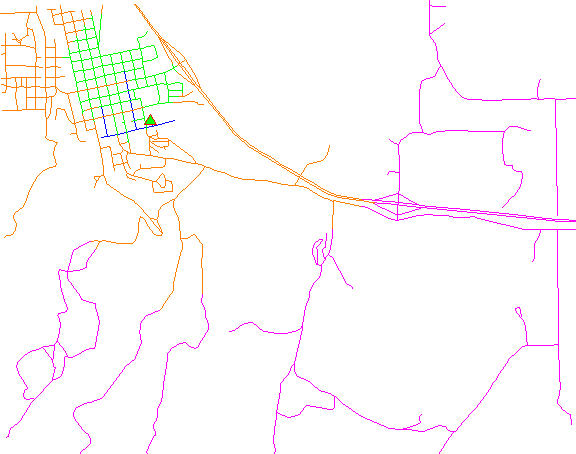

Note: A new GRASS GIS stable version has been released: GRASS GIS 7. Go directly to the new manual page here
Costs may be either line lengths, or attributes saved in a database
table. These attribute values are taken as costs of whole segments, not
as costs to traverse a length unit (e.g. meter) of the segment.
For example, if the speed limit is 100 km / h, the cost to traverse a
10 km long road segment must be calculated as
length / speed = 10 km / (100 km/h) = 0.1 h.
Supported are cost assignments for both arcs and nodes,
and also different costs for both directions of a vector line.
For areas, costs will be calculated along boundary lines.
The input vector needs to be prepared with v.net operation=connect in order to connect points representing center nodes to the network.
Nodes must be on the isolines.
Isonetwork using distance:

Isonetwork using time:

# Spearfish # start node: echo "591280.5|4926396.0|1" | v.in.ascii in=- out=startnode g.copy vect=roads,myroads # connect point to network v.net myroads points=startnode out=myroads_net op=connect thresh=200 # define iso networks using distance: v.net.iso input=myroads_net output=myroads_net_iso ccats=1-100000 costs=1000,2000,5000
v.category myroads_net_iso option=report # ... reports 4 categories: #cat | distance from point in meters #1 0 - < 1000 #2 1000 - < 2000 #3 2000 - < 5000 #4 >= 5000
g.region n=4928200 s=4922300 w=589200 e=596500 d.mon x0 d.vect myroads_net_iso col=blue cats=1 d.vect myroads_net_iso col=green cats=2 d.vect myroads_net_iso col=orange cats=3 d.vect myroads_net_iso col=magenta cats=4 d.vect myroads_net col=red icon=basic/triangle fcol=green size=12 layer=2
# Spearfish # start node: echo "591280.5|4926396.0|1" | v.in.ascii in=- out=startnode g.copy vect=roads,myroads # connect point to network v.net myroads points=startnode out=myroads_net op=connect thresh=200
# set up costs # create unique categories for each road in layer 3 v.category in=myroads_net out=myroads_net_time opt=add cat=1 layer=3 type=line # add new table for layer 3 v.db.addtable myroads_net_time layer=3 col="cat integer,label varchar(43),length double precision,speed double precision,cost double precision,bcost double precision" # copy road type to layer 3 v.to.db myroads_net_time layer=3 qlayer=1 opt=query qcolumn=label columns=label # upload road length in miles v.to.db myroads_net_time layer=3 type=line option=length col=length unit=miles # set speed limits in miles / hour v.db.update myroads_net_time layer=3 col=speed val="5.0" v.db.update myroads_net_time layer=3 col=speed val="75.0" where="label='interstate'" v.db.update myroads_net_time layer=3 col=speed val="75.0" where="label='primary highway, hard surface'" v.db.update myroads_net_time layer=3 col=speed val="50.0" where="label='secondary highway, hard surface'" v.db.update myroads_net_time layer=3 col=speed val="25.0" where="label='light-duty road, improved surface'" v.db.update myroads_net_time layer=3 col=speed val="5.0" where="label='unimproved road'" # define traveling costs as traveling time in minutes: # set forward costs v.db.update myroads_net_time layer=3 col=cost val="length / speed * 60" # set backward costs v.db.update myroads_net_time layer=3 col=bcost val="length / speed * 60" # define iso networks using traveling time: v.net.iso input=myroads_net_time output=myroads_net_iso_time alayer=3 nlayer=2 afcol=cost abcol=bcost ccats=1-100000 costs=1,2,5
# add table with labels and coloring v.db.addtable myroads_net_iso_time columns="cat integer,trav_time varchar(20),GRASSRGB varchar(11)" # labels v.db.update map=myroads_net_iso_time layer=1 column=trav_time value="0 - 1" where="cat = 1" v.db.update map=myroads_net_iso_time layer=1 column=trav_time value="1 - 2" where="cat = 2" v.db.update map=myroads_net_iso_time layer=1 column=trav_time value="2 - 5" where="cat = 3" v.db.update map=myroads_net_iso_time layer=1 column=trav_time value="> 5" where="cat = 4" # colors # cats=1: blue v.db.update map=myroads_net_iso_time layer=1 column=GRASSRGB value="000:000:255" where="cat = 1" # cats=2: green v.db.update map=myroads_net_iso_time layer=1 column=GRASSRGB value="000:255:000" where="cat = 2" # cats=3: orange v.db.update map=myroads_net_iso_time layer=1 column=GRASSRGB value="255:128:000" where="cat = 3" # cats=4: magenta v.db.update map=myroads_net_iso_time layer=1 column=GRASSRGB value="255:000:255" where="cat = 4" # show results g.region n=4928200 s=4922300 w=589200 e=596500 d.mon x0 d.vect myroads_net_iso_time layer=1 -a rgb_col=GRASSRGB d.vect myroads_net col=red icon=basic/triangle fcol=green size=12 layer=2
Last changed: $Date: 2013-05-23 13:01:55 -0700 (Thu, 23 May 2013) $
Main index - vector index - Full index
© 2003-2016 GRASS Development Team